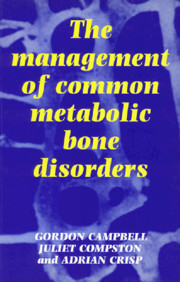3 - Osteomalacia
Published online by Cambridge University Press: 06 July 2010
Summary
Osteomalacia, meaning soft bones, was first recognised as a separate entity from osteoporosis by the German pathologist Pommer in 1885. It is a condition in which there is a failure of bone mineralisation usually resulting histologically in an excess of poorly calcified osteoid bone matrix. In rickets, in children, there is an additional defective mineralisation of cartilage, and in particular of the epiphyseal growth plates.
The clinical importance of the condition lies in the skeletal deformities and manifestations of hypocalcaemia produced in early life and the muscle weakness, bone pain and fractures seen in adults. The main causes (Table 3.1) can be summarised as either due to a deficiency of Vitamin D and its metabolites or due to resistance to the vitamin. The cause of osteomalacia in developed countries is mainly confined to those affected by Vitamin D deficiency, and therefore the majority of this chapter is devoted to the management of these groups of patients, although some of the other rarer causes are discussed for information.
Vitamin D deficiency
This privational form of osteomalacia is mainly associated with young adults in the Asian community and with the elderly in the general population. In the Asian community, the disease mainly affects young women and girls during the pubertal spurt in bone growth. The prevalence in the elderly population is not known, but studies on unselected acute admissions to geriatric units in the UK suggest a figure of 4% in those admissions.
- Type
- Chapter
- Information
- The Management of Common Metabolic Bone Disorders , pp. 63 - 82Publisher: Cambridge University PressPrint publication year: 1993



